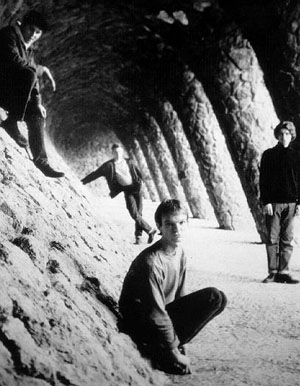The mayor’s office in Bootleg City was completely dark as I cracked open the door.
”Thank God,” I thought to myself. I had absentmindedly left my Cure reissues there before Christmas and was hoping to sneak in and pick them up without incident. As I fumbled for the light switch, however, an inexplicable chill washed over me, as icy and slick as a Trevor Horn production.
To my horror, I soon realized why. Although it was the end of the first week of 2010, it became clear that Mayor Cass hadn’t yet been into work this decade. A crooked ”Happy New Year!” sign drooped onto the curtains, while half-eaten Hot Pockets congealed on plastic plates on a nearby table. Flimsy cups filled with cheap champagne decorated the cluttered mayoral desk, the bubbles long since fizzled out.
A weeklong bender seemed unlikely, even for Mayor Cass, but I dutifully checked every alley behind every bar I knew he frequented, looking for the telltale slumped figure. I found nothing.
Several calls to Heaven Is One Coffee-Stained Couch Donation Away, the local Christian thrift store where the mayor shops for records, also yielded no signs of him, and his cell phone went straight to voice mail. On top of all that, his house was dark and locked.
I knew this could mean only one thing: Mayor Cass was missing.
My sleuthing days had ended sometime after I finished the Nancy Drew series back in elementary school, but I recalled several smudged lipstick prints on one of the champagne cups. A secret tryst seemed the most logical conclusion. However, the question remained: who would be desperate enough to rendezvous with the bitter, immoral, cranky, prog-loving legislator? I was determined to find out. After all, the livelihood of Bootleg City depended on it.
To be continued …
 Mystery and intrigue are also an integral part of the House of Love’s legacy. Its debut single, 1987’s ”Shine On,” is a majestic classic full of keening psych-pop guitars, yearning vocals, and an indelible but inscrutable chorus: ”She / She, she, she shine on.” The UK band refined and expanded upon this template on four studio albums over the next six years before finally imploding in 1993.
Mystery and intrigue are also an integral part of the House of Love’s legacy. Its debut single, 1987’s ”Shine On,” is a majestic classic full of keening psych-pop guitars, yearning vocals, and an indelible but inscrutable chorus: ”She / She, she, she shine on.” The UK band refined and expanded upon this template on four studio albums over the next six years before finally imploding in 1993.
Nothing was ever straightforward with the House of Love, though. Of their four studio albums, two were self-titled and appeared on different labels: Creation Records handled the band’s 1988 debut, while 1990’s so-called “Butterfly Album” (due to its cover art) came out on major-label subsidiary Fontana. This doesn’t even take into account a German-produced self-titled compilation from 1987 that combined two early singles and the group’s B-sides with unreleased tracks. (A new version with extra songs and a different track listing was issued via Renascent in recent years.)
The House of Love’s discography chaos matched their interpersonal drama; alleged drug use, the pressures of instant stardom, and label demands plagued the band. Guitarist Terry Bickers, considered the band’s creative rock next to vocalist and fellow cofounder Guy Chadwick, left near the end of ’89, and the band’s first album without him, 1992’s dream-pop classic Babe Rainbow, was much slicker and commercial sounding than previous efforts. (”You Don’t Understand” even hit #8 on Billboard’s Modern Rock chart.)
Still, it’s a bridge album between Madchester’s Technicolor swagger, shoegaze’s swirling melancholy, and Britpop’s impending clear-eyed precision. In contrast, the House of Love’s then-swan song, 1993’s Audience With the Mind, can be found at nearly every used record store on the cheap (I’ve yet to find somebody who will vouch for it).
The group has remained in the spotlight in recent years thanks to a slew of reissues and repackaging: a Peel Sessions collection arrived in 2000, Renascent reissued the 1988 eponymous album (which is different from 2001’s 1986-88: The Creation Recordings) in ’07, and the excellent Live at the BBC compilation came out last year. Moreover, a House of Love reformation last decade yielded one album, the underrated, import-only 2005 disc Days Run Away, and well-received concerts overseas.
The following performance from the Paradiso in Amsterdam in the spring of 1990 dates from just after Bickers’s departure. But the set list, which encapsulates the best bits of the House of Love’s first two albums, is stellar. Stripped of their studio gloss, the songs are full of strident guitars, optimistic despondence, and Chadwick’s haunted voice, which cracks like a schoolboy’s on the set’s final song, ”Destroy the Heart.”
Hannah
I Don’t Know Why I Love You
32nd Floor
Hope
Shake and Crawl
Never
Road
Beatles and the Stones
Love in a Car
Into the Tunnel
Nothing to Me
Shine On
Salome
Christine
Plastic
Real Animal
Se Dest
Destroy the Heart




Comments